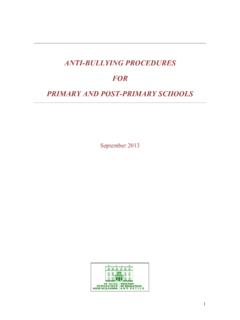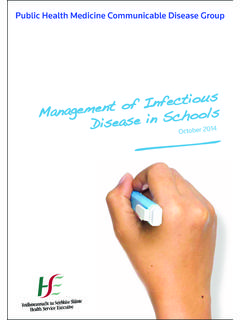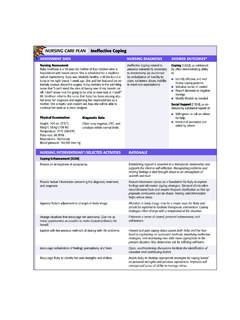Transcription of Delivering Equality of Opportunity in Schools - education.ie
1 Delivering Equality of Opportunity in Schools 1. Contents Foreword .. 4. DEIS Plan 2017 Goals and 17. Goal 1 To implement a more robust and responsive Assessment Framework for identification of Schools and effective resource allocation .. 17. Goal 2 To improve the learning experience and outcomes of pupils in DEIS Schools .. 23. Goal 3 To improve the capacity of school leaders and teachers to engage, plan and deploy resources to their best advantage .. 34. Goal 4 To Support and Foster Best Practice in Schools through Inter-Agency Collaboration .. 45. Goal 5 To support the work of Schools by providing the research, information, evaluation and feedback to achieve the goals of the Plan .. 53. Appendices .. 56. Appendix 1 Supports Provided under the DEIS School Support Programme 2017 * .. 56. Appendix 2 - Glossary of Terms and Abbreviations .. 58. 2. 3. Foreword Our ambition is to have the best education and training system in Europe within the decade. It includes the goals of improving the path of educational Opportunity for those who come to education at a disadvantage and of strengthening the capacity of education and training to break cycles in communities with high concentrations of disadvantage.
2 Much of the work of school leaders, teachers, the Department of Education and Skills and its agencies is to ensure that any pupil or student who might struggle in education gets the best possible support. Special programmes are in place for children with learning challenges. In addition, the programme DEIS ( Delivering Equality of Opportunity in Schools ) was designed to give tailored support to Schools who have high concentration of disadvantage. A review of that programme has shown real improvements in terms of educational outcomes and in the progression through school for students involved. It has also identified areas for improvement which signpost the way ahead. This new plan sets out new goals to be achieved in terms of improved outcomes for children. The aim is to narrow the gaps and develop better pathways. The plan will: develop best practice in identification of Schools needing support, pilot new approaches that can be mainstreamed over time, integrate the range of supports with other Departments and Agencies for optimal impact and aims to devise greater continuity of support across a wider range of Schools over time.
3 My hope is that, over time, we can equip all Schools to offer a learning environment in which any child can thrive without labelling of child or of school. By ensuring the best possible outcome, we can maximise the chances of every child getting the best possible Opportunity to fulfil his or her potential in life. This is a journey, and this plan represents an important step on that journey. Richard Bruton Minister for Education and Skills. 4. 5. The DEIS Plan 2017, which replaces the current Action Plan launched in 2005, sets out our vision for future intervention in the critical area of social inclusion in education policy. Our Vision For Education to more fully become a proven pathway to better opportunities for those in communities at risk of disadvantage and social exclusion. Our Ambition To become the best in Europe at harnessing education to break down barriers and stem the cycle of inter-generational disadvantage by equipping learners to participate, succeed and contribute effectively to society in a changing world.
4 Our Targets To realise our vision we have devised an ambitious set of targets. Measure Target DEIS LITERACY RATES1 INCREASE THE PERCENTAGE OF PUPILS IN SECOND AND. SIXTH CLASS IN DEIS BAND 1 Schools PERFORMING. [RELEVANT INDICATORS: NATIONAL ASSESSMENTS OF AT LEVEL 3 OR HIGHER IN READING LITERACY FROM. ENGLISH READING AND MATHEMATICS (NAERM); 18% AND 21% TO 25% AND 27% RESPECTIVELY BY. PROGRAMME FOR INTERNATIONAL STUDENT 2020. ASSESSMENT (PISA)]. INCREASE THE PERCENTAGE OF 15 YEAR OLD. STUDENTS IN DEIS Schools PERFORMING AT OR. ABOVE LEVEL 4 IN READING LITERACY FROM 28% TO. 33% BY 2020. INCREASE THE PERCENTAGE OF 15 YEAR OLD. STUDENTS IN DEIS Schools PERFORMING AT OR. ABOVE LEVEL5 IN READING LITERACY FROM 7% TO. 10% BY 2020. REDUCE THE PERCENTAGE OF PUPILS IN SECOND AND. SIXTH CLASS IN DEIS BAND 1 Schools PERFORMING. AT OR BELOW LEVEL 1 IN READING LITERACY FROM. 44% AND 47% RESPECTIVELY TO 40% BY 2020. REDUCE THE PERCENTAGE OF 15 YEAR OLD STUDENTS. IN DEIS Schools PERFORMING AT OR BELOW LEVEL 1.
5 IN READING LITERACY FROM 16% TO 12% BY 2020. 1. Target developed as part of the Interim Review of the National Strategy on Literacy and Numeracy for Learning and Life 2011-2020. 6. DEIS NUMERACY RATES2 INCREASE THE PERCENTAGE OF PUPILS IN SECOND AND. SIXTH CLASS IN DEIS BAND 1 Schools PERFORMING. AT LEVEL 3 OR HIGHER IN MATHEMATICS FROM 21%. AND 19% TO 30% AND 27% RESPECTIVELY BY 2020. INCREASE THE PERCENTAGE OF 15 YEAR OLD. STUDENTS IN DEIS Schools PERFORMING AT OR. ABOVE LEVEL 4 IN MATHEMATICS FROM 23% TO 29%. BY 2020. INCREASE THE PERCENTAGE OF 15 YEAR OLD. STUDENTS IN DEIS Schools PERFORMING AT OR. ABOVE LEVEL 5 IN MATHEMATICS FROM 6% TO 10%. BY 2020. REDUCE THE PERCENTAGE OF PUPILS IN SECOND AND. SIXTH CLASS IN DEIS BAND 1 Schools PERFORMING. AT OR BELOW LEVEL 1 IN MATHEMATICS FROM 52%. AND 50% TO 45% AND 42% RESPECTIVELY BY 2020. REDUCE THE PERCENTAGE OF 15 YEAR OLD STUDENTS. IN DEIS Schools PERFORMING AT OR BELOW LEVEL 1. IN MATHEMATICS FROM 22% TO 16% BY 2020.
6 DEIS PUPIL RETENTION RATES CONTINUE TO IMPROVE RETENTION RATES AT SECOND- LEVEL IN DEIS Schools , FROM THEIR CURRENT RATE. OF TO THE NATIONAL NORM, CURRENTLY. , BY 2025. STUDENT WELLBEING EXTEND THE INCREDIBLE YEARS TEACHER. PROGRAMME IN DEIS PRIMARY Schools TO. INCREASE REACH FROM C. 20,000 LEARNERS IN 130. Schools TO 104,000 LEARNERS IN 646 Schools BY. 2019. EXTEND FRIENDS PROGRAMME IN DEIS Schools TO. INCREASE REACH FROM C. 25,000 LEARNERS IN 275. Schools TO 172,000 LEARNERS IN 831 Schools BY. 2019. PROGRESSION TO FURTHER AND HIGHER EDUCATION INCREASE THE PERCENTAGE OF PEOPLE FROM THE. NON-MANUAL WORKER GROUP IN HIGHER. EDUCATION TO 30% BY 2019. 2. Target developed as part of the Interim Review of the National Strategy on Literacy and Numeracy for Learning and Life 2011-2020. 7. INCREASE THE PERCENTAGE OF PEOPLE FROM THE. SEMI/UNSKILLED MANUAL WORKER GROUP IN HIGHER. EDUCATION TO 35% BY 2019. INCREASE THE PERCENTAGE OF FIRST-TIME MATURE. STUDENTS IN HIGHER EDUCATION TO 16% IN THE.
7 CASE OF FULL-TIME MATURE STUDENTS AND 24% IN. THE CASE OF FULL AND PART-TIME/FLEXIBLE MATURE. STUDENTS BY 2019. INCREASE THE PERCENTAGE OF STUDENTS STUDYING. ON A PART-TIME/FLEXIBLE BASIS IN HIGHER. EDUCATION TO 22% BY 2019. INCREASE THE PERCENTAGE OF NEW ENTRANTS TO. HIGHER EDUCATION WHOSE BASIS FOR ADMISSION TO. HIGHER EDUCATION IS A FURTHER EDUCATION. QUALIFICATION TO 10% BY 2019. INCREASE THE NUMBER OF IRISH TRAVELLERS IN. HIGHER EDUCATION TO 80 BY 2019. TEACHER EDUCATION INCREASE ACCESS BY STUDENTS FROM TARGET. GROUPS TO INITIAL TEACHER EDUCATION BY 2018. ENHANCE TEACHER EDUCATION AND PROFESSIONAL. DEVELOPMENT PROGRAMMES TO SUPPORT THE. RAISING OF EXPECTATIONS AMONG STUDENTS IN. RELATION TO THEIR HIGHER EDUCATION POTENTIAL. PARENTAL ENGAGEMENT IMPROVE THE LEVEL OF PARENTAL ENGAGEMENT IN. THEIR SCHOOL COMMUNITIES THROUGH BETTER. SCHOOL PLANNING AND TUSLA SERVICE PLANNING. COMMUNITY LINKS IMPROVE LINKAGES THAT HELP STUDENTS ENGAGE IN. COMMUNITY ACTIVITIES THROUGH BETTER SCHOOL.
8 PLANNING AND IMPROVED ENGAGEMENT WITH LOCAL. COMMUNITY DEVELOPMENT COMMITTEES, AND. CHILDREN AND YOUNG PEOPLE'S SERVICES. COMMITTEES. These targets are set based on available metrics but we aim to continue to refine our capacity to measure programmes with new indicators. 8. Our goals In order to achieve the targets we have set, and building on the five key goals set out in the Action Plan for Education 2016-2019, the Key Goals we have set ourselves in this DEIS Plan are: Goal 1 Goal 2 Goal 3 Goal 4 Goal 5. To implement To improve To improve the To support To support the a more robust the learning capacity of and foster work of Schools and responsive experience school leaders best practice by providing the Assessment and teachers in Schools research, and Framework for to engage, plan through inter- information, outcomes of evaluation and identification and deploy agency of Schools and pupils in resources to feedback to DEIS Schools collaboration achieve the effective their best resource advantage.
9 Goals of the allocation Plan There is a consistent emphasis in international research on educational disadvantage on the importance of early intervention, and the strong effects of intensive early intervention on medium and long-term outcomes. Interventions in other countries to address educational disadvantage fall broadly into three categories, intensive programmes in early childhood education, measures designed to improve academic achievement, including class size and literacy programmes and compensatory or targeted funding for disadvantaged Schools and areas. The DEIS School Support Programme has adopted a similar approach with an emphasis on supporting Schools in the delivery of literacy and numeracy programmes and providing additional core funding, together with resourcing smaller classes for junior pupils in the most disadvantaged Schools . There has been a particular emphasis in the Irish context on the adoption of a whole school approach, which is recognised internationally, to enable Schools respond to new and complex challenges linked to increasing diversity in society.
10 This involves the entire school community (school Principals, teaching and non-teaching staff, learners, parents and families) in a cohesive, collective and collaborative engagement with external stakeholders and the community at large to effect better outcomes for all. Research has consistently pointed to education as a shared responsibility between parents and the school. In the Irish context, unlike other jurisdictions, parents have constitutional and legislative recognition as the first educators of their children with a critical role in their children's educational journey. The success of Ireland's Home School Community Liaison scheme, which promotes parental involvement through empowerment, to support their children's education, has seen it recognised as an innovative measure in other jurisdictions. 9. The DEIS Plan identifies more than 100 actions in support of the goals we have identified. These actions will ensure that the targets we have set will be achieved and learners most at risk of disadvantage will experience improved outcomes.












